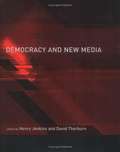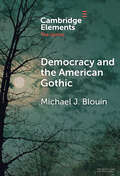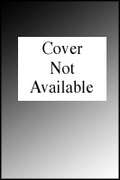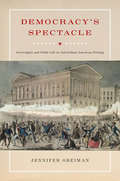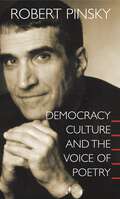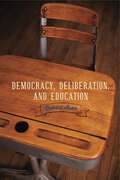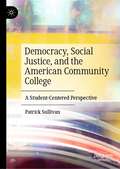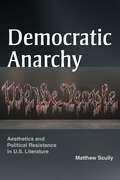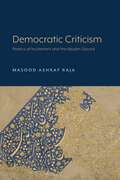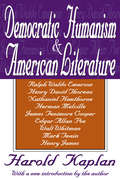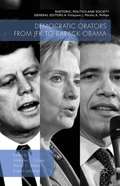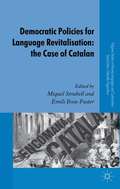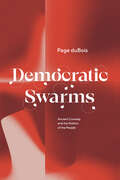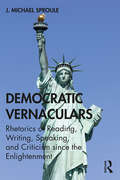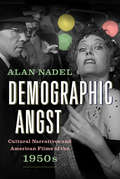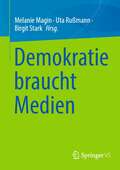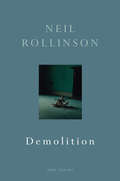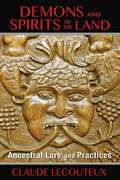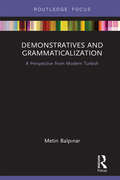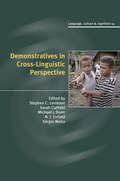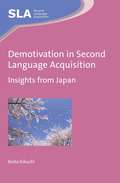- Table View
- List View
Democracy and Media Decadence
by John KeaneWe live in a revolutionary age of communicative abundance in which many media innovations - from satellite broadcasting to smart glasses and electronic books - spawn great fascination mixed with excitement. In the field of politics, hopeful talk of digital democracy, cybercitizens and e-government has been flourishing. This book admits the many thrilling ways that communicative abundance is fundamentally altering the contours of our lives and of our politics, often for the better. But it asks whether too little attention has been paid to the troubling counter-trends, the decadent media developments that encourage public silence and concentrations of unlimited power, so weakening the spirit and substance of democracy. Exploring examples of clever government surveillance, market censorship, spin tactics and back-channel public relations, John Keane seeks to understand and explain these trends, and how best to deal with them. Tackling some tough but big and fateful questions, Keane argues that 'media decadence' is deeply harmful for public life.
Democracy and New Media
by Henry Jenkins David ThorburnDigital technology is changing our politics. The World Wide Web is already a powerful influence on the public's access to government documents, the tactics and content of political campaigns, the behavior of voters, the efforts of activists etc.
Democracy and the American Gothic (Elements in the Gothic)
by Michael J. BlouinWhile the political undercurrent of the American Gothic has been firmly established, few scholars have surveyed the genre's ambivalent relationship to democracy. The American Gothic routinely undercuts centralised authority by exposing the dark underbelly of the status quo; at the same time, the American Gothic tends to reflect a widespread mistrust of the masses. American readers are too afraid of democracy – and not yet fearful enough. This concise Element theorises the democratic and anti-democratic elements of the American Gothic by surveying the conflicted imaginaries of the genre's mainstays, including Charles Brockden Brown, Edgar Allan Poe, Shirley Jackson, and Stephen King.
Democracy and the Politics of Silence (Rhetoric and Democratic Deliberation)
by Mónica Brito VieiraMost people equate democracy with discussion, speech, and making one’s voice heard. But where does silence fit in? Democracy and the Politics of Silence investigates the largely overlooked role of silence in democratic politics. It challenges conventional wisdom by arguing that silence can support and affirm democratic pillars and outcomes like empowerment, inclusion, and equality.The book focuses on a particular set of problems concerning the relationship between political silence and the democratic triad of voice, agency, and representation. Each of the book’s chapters draws on a selection of hand-picked case studies, both historical and contemporary, including the NAACP’s Silent Parade in 1917, demonstrations by the Women in Black, Spain’s post-Franco Pact of Forgetting, Trump’s silent majority, debates related to the representation of nonhuman beings, and the famous Miranda judgment on the right to silence. Together they offer an innovative, ambitious investigation of democratically undesirable silences and practices of silence that are powerfully affirmative of democratic subjectivities, aims, and norms. In thus expanding the repertoire of democratic citizenship, Mónica Brito Vieira invites readers to consider what silence might teach them about democracy.This timely book should appeal to political science students and scholars as well as anyone interested in the history of democracies and popular resistance movements.
Democracy as Fetish (RSA Series in Transdisciplinary Rhetoric #13)
by Ralph CintronDemocracy has long been fetishized. Consequently, how we speak about democracy and what we expect from democratic governance are at odds with practice. With unflinching resolve, this book probes the theory of democracy and how the left and right are fascinated by it.In this innovative multidisciplinary study, Ralph Cintron provides sustained analysis of our political discourse. He shows not only how the rhetoric of democracy produces strong desires for social order, global wealth, and justice but also how these desires cannot be satisfied. Throughout his discussion, Cintron includes ethnographic research from fieldwork conducted over the course of twenty years in the Latino neighborhoods of Chicago, where he observes both citizens and the undocumented looking to democracy to fulfill their highest aspirations. Politicians hand out favors to the elite, developers strong-arm aldermen, and the disenfranchised have little redress. The problem, Cintron argues, is that the conditions required to put democracy into practice—territory, a bordered nation-state, citizens, property—are constituted by inequality and violence, because there is no inclusivity that does not also exclude.Drawing on ethnography, economics, political theory, and rhetorical analysis, Cintron makes his case with tremendous analytic rigor. This challenge to reassess the discourses on democracy and to consider democratic politics as always compromised by oligarchy will be of particular interest to political and rhetorical theorists.
Democracy as Fetish (RSA Series in Transdisciplinary Rhetoric)
by Ralph CintronDemocracy has long been fetishized. Consequently, how we speak about democracy and what we expect from democratic governance are at odds with practice. With unflinching resolve, this book probes the theory of democracy and how the left and right are fascinated by it.In this innovative multidisciplinary study, Ralph Cintron provides sustained analysis of our political discourse. He shows not only how the rhetoric of democracy produces strong desires for social order, global wealth, and justice but also how these desires cannot be satisfied. Throughout his discussion, Cintron includes ethnographic research from fieldwork conducted over the course of twenty years in the Latino neighborhoods of Chicago, where he observes both citizens and the undocumented looking to democracy to fulfill their highest aspirations. Politicians hand out favors to the elite, developers strong-arm aldermen, and the disenfranchised have little redress. The problem, Cintron argues, is that the conditions required to put democracy into practice—territory, a bordered nation-state, citizens, property—are constituted by inequality and violence, because there is no inclusivity that does not also exclude.Drawing on ethnography, economics, political theory, and rhetorical analysis, Cintron makes his case with tremendous analytic rigor. This challenge to reassess the discourses on democracy and to consider democratic politics as always compromised by oligarchy will be of particular interest to political and rhetorical theorists.
Democracy's Spectacle: Sovereignty and Public Life in Antebellum American Writing
by Jennifer Greiman"What is the hangman but a servant of law? And what is that law but an expression of public opinion? And if public opinion be brutal and thou a component part thereof, art thou not the hangman's accomplice?" Writing in 1842, Lydia Maria Child articulates a crisis in the relationship of democracy to sovereign power that continues to occupy political theory today. Is sovereignty, with its reliance on singular and exceptional power, fundamentally inimical to democracy? Or might a more fully realized democracy distribute, share, and popularize sovereignty, thus blunting its exceptional character and its basic violence? In Democracy's Spectacle, Jennifer Greiman looks to an earlier moment in the history of American democracy's vexed interpretation of sovereignty to argue that such questions about the popularization of sovereign power shaped debates about political belonging and public life in the antebellum United States. In an emergent democracy that was also an expansionist slave society, Greiman argues, the problems that sovereignty posed were less concerned with a singular and exceptional power lodged in the state than with a power over life and death that involved all Americans intimately.Drawing on Alexis de Tocqueville's analysis of the sovereignty of the people in Democracy in America, along with work by Gustave de Beaumont, Lydia Maria Child, Nathaniel Hawthorne, and Herman Melville, Greiman tracks the crises of sovereign power as it migrates out of the state to become a constitutive feature of the public sphere. Greiman brings together literature and political theory, as well as materials on antebellum performance culture, antislavery activism, and penitentiary reform, to argue that the antebellum public sphere, transformed by its empowerment, emerges as a spectacle with investments in both punishment and entertainment.
Democracy, Culture and the Voice of Poetry (The University Center for Human Values Series #27)
by Robert PinskyThe place of poetry in modern democracy is no place, according to conventional wisdom. The poet, we hear, is a casualty of mass entertainment and prosaic public culture, banished to the artistic sidelines to compose variations on insipid themes for a dwindling audience. Robert Pinsky, however, argues that this gloomy diagnosis is as wrongheaded as it is familiar. Pinsky, whose remarkable career as a poet itself undermines the view, writes that to portray poetry and democracy as enemies is to radically misconstrue both. The voice of poetry, he shows, resonates with profound themes at the very heart of democratic culture. There is no one in America better to write on this topic. One of the country's most accomplished poets, Robert Pinsky served an unprecedented two terms as America's Poet Laureate (1997-2000) and led the immensely popular multimedia Favorite Poem Project, which invited Americans to submit and read aloud their favorite poems. Pinsky draws on his experiences and on characteristically sharp and elegant observations of individual poems to argue that expecting poetry to compete with show business is to mistake its greatest democratic strength--its intimate, human scale--as a weakness. As an expression of individual voice, a poem implicitly allies itself with ideas about individual dignity that are democracy's bedrock, far more than is mass participation. Yet poems also summon up communal life.. Even the most inward-looking work imagines a reader. And in their rhythms and cadences poems carry in their very bones the illusion and dynamic of call and response. Poetry, Pinsky writes, cannot help but mediate between the inner consciousness of the individual reader and the outer world of other people. As part of the entertainment industry, he concludes, poetry will always be small and overlooked. As an art--and one that is inescapably democratic--it is massive and fundamental.
Democracy, Deliberation, and Education (Rhetoric and Democratic Deliberation #13)
by Robert AsenThe local school board is one of America’s enduring venues of lay democracy at work. In Democracy, Deliberation, and Education, Robert Asen takes the pulse of this democratic exemplar through an in-depth study of three local school boards in Wisconsin. In so doing, Asen identifies the broader democratic ideal in the most parochial of American settings. Conducted over two years across racial, ethnic, and socioeconomic lines, Asen’s research reveals as much about the possibilities and pitfalls of local democracy as it does about educational policy. From issues as old as racial integration and as contemporary as the recognition of the Gay-Straight Alliance in high schools, Democracy, Deliberation, and Education illustrates how ordinary folks build and sustain their vision for a community and its future through consequential public decision making.For all the research on school boards conducted in recent years, no other project so directly addresses school boards as deliberative policymaking bodies. Democracy, Deliberation, and Education draws from 250 school-board meetings and 31 interviews with board members and administrators to offer insight into participants’ varied understandings of their roles in the complex mechanism of governance.
Democracy, Social Justice, and the American Community College: A Student-Centered Perspective
by Patrick SullivanThis book provides scholars, educators, and legislators with a personal, classroom-level tour of daily life at a community college. Readers will accompany the author into the classroom as he goes about his work as an English teacher meeting with classes and corresponding with students on Blackboard and e-mail. Answering the call for ”student-centered scholarship,” this book blends traditional academic writing with chapters that feature a rich variety of student work, including essays, journal entries, poems, art, and responses to creative assignments. In this volume, Sullivan theorizes the modern community college as a social justice institution. By mission and mandate, the modern community college has democratized America’s system of higher education and distributed hope, equity, and opportunity more broadly across the nation.
Democratic Anarchy: Aesthetics and Political Resistance in U.S. Literature
by Matthew ScullyA dramatic and necessary rethinking of the meaning of DemocracyDemocratic Anarchy grapples with an uncomfortable but obvious truth inimical to democracy: both aesthetics and politics depend on the structuring antagonism of inclusion and exclusion. Yet in Democratic Anarchy, Matthew Scully asks, how can “the people” be represented in a way that acknowledges what remains unrepresentable? What would it mean to face up to the constitutive exclusions that haunt U.S. democracy and its anxious fantasies of equality?Synthesizing a broad range of theoretical traditions and interlocutors—including Lacan, Rancière, Edelman, and Hartman—Democratic Anarchy polemically declares that there has never been, nor can there ever be, a realized democracy in the U.S. because democracy always depends on the hierarchical institution of a formal order by one part of the population over another. Engaging with an expansive corpus of American literature and art (Harriet Jacobs, Nathaniel Hawthorne, Louis Zukofsky, Thomas Pynchon, Toni Morrison, Theresa Hak Kyung Cha, Nari Ward, Ocean Vuong, and Safiya Sinclair), Democratic Anarchy argues that many liberal concepts and institutions are in fact structurally opposed to democratic equality because they depend on regulating what can appear and in what form.By focusing on works that disrupt this regulatory impulse, Scully shows how rhetorical strategies of interruption, excess, and disorder figure the anarchic equality that inegalitarian fantasies of democracy disavow. Democratic Anarchy develops a rigorous theory of equality that refuses to repeat the inequalities against which it positions itself, and it does so by turning to moments of resistance—both aesthetic and political—inaugurated by the equality that inheres in and antagonizes the order of things.
Democratic Criticism: Poetics of Incitement and the Muslim Sacred
by Masood Ashraf RajaAfter the publication of Salman Rushdie’s The Satanic Verses (1988), the poetics of incitement— found in texts originating in the West containing themes and representations of Islam hurtful to Muslims—became an accepted method of textual production in the West. Production of such texts intensified after the attacks of 9/11. Democratic Criticism: Poetics of Incitement and the Muslim Sacred by Masood Ashraf Raja urges a new mode of reading, one that permits Western readers to transcend local reading practices in order to, as best as one can, read from the point of view of the Other. Raja argues that the lack of understanding of Muslim responses to the poetics of incitement in the West is the result of a lack of cross-cultural knowledge. He claims metropolitan universities often do not teach the proper social, historical, and religious context required for effectively reading these texts with any form of cultural knowledge. To remedy this, Raja offers and theorizes “democratic reading practices” and new ways for students to engage with texts. A genealogy of the Muslim Sacred is included, thereby giving readers the history and specific knowledge that constitutes an average Muslim reader of these texts, a subject who should be imagined and empathized with when those in the West read works of the poetics of incitement. Democratic Criticism encourages Western readers to develop a deeper understanding of the meaning-making processes of the Islamic world while at the same time encouraging the Muslim readers to read representations of the Islamic world with a more expansive understanding. It will be a helpful tool in creating reading practices that allow both teachers and students of literature to transcend their mode of reading as universal and to read from the perspective of the Other, and allow readers to engage meaningfully with these texts. Students and scholars of world literature, history, and religious studies will find this book insightful and valuable.
Democratic Humanism and American Literature
by Harold KaplanDemocratic Humanism and American Literature illustrates the interplay between democratic assumptions and literary performance in the America's classic nineteenth-century writers--Emerson, Thoreau, Hawthorne, Melville, Cooper, Poe, Whitman, Twain, and James. Harold Kaplan suggests that these major figures' works are linked by the myths of genesis of a new political culture. Challenged by the democratic ideal, and committed to it, they wrote prophetic books in the American liberal tradition and endowed its ethical intelligence.The task of stating a new and undefined freedom was always implicit and often in the foreground of the writing of these nineteenth-century giants. As the author describes the situation, "the free man had to decide in what sense he was bound by nature or could master it; in what sense he was committed to his society and could reconcile his freedom with it." These classic writers devoted their work to examining this dialectic of values; Kaplan sees their complex and polarized democratic consciousness as seminal in the imaginative tradition they generated. What is unique in that tradition of values is the rivalry of criticism with affirmations of faith. "The highly original ethical trait involved here is based on the capacity of a political society to use its negations against itself and survive."The author suggests that in our own time moral judgments are more likely to be the province of activist politics than literature. His new introduction relates the theme of the book to cultural and political developments in the American experience of modernity and adds a discussion of Wallace Stevens and William Carlos Williams to the figures treated in the original edition. Since tendencies to develop ideological and idiosyncratic responses to extrinsic events have grown stronger over time, it is more important than ever for scholars and students alike to recover a "moral imagination"--the force that gave rise to the great literary works of the nineteenth century. To describe that force is Harold Kaplan's goal in Democratic Humanism and American Literature.
Democratic Orators from JFK to Barack Obama (Rhetoric, Politics And Society Ser.)
by Robert Lehrman David Moon Andrew CrinesHow do leading Democratic Party figures strive to communicate with and influence their audience? Why have some proven more successful than others in advancing their ideological arguments? How do orators seek to connect with different audiences in different settings such as the Senate, conventions and through the media? This thoroughly researched and highly readable collection comprehensively evaluates these questions as well as providing an extensive interrogation of the political and intellectual significance of oratory and rhetoric in the Democratic Party. Using the Aristotelian modes of persuasion ethos, pathos and logos it draws out commonalties and differences in how the rhetoric of Democratic Party politics has shifted since the 1960s. More broadly it evaluates the impact of leading orators upon American politics and argues that effective oratory remains a vital party of American political discourse.
Democratic Policies for Language Revitalisation: the Case of Catalan
by Emili Boix-Fuster Miquel StrubellA collection of studies offering an up-to-date analysis of official policies to promote Catalan in a democratic framework in each of the main Spanish regions where it is spoken: Catalonia, Valencia and the Balearic Islands.
Democratic Swarms: Ancient Comedy and the Politics of the People
by Page duBoisConsiders how ancient Greek comedy offers a model for present-day politics. With Democratic Swarms, Page duBois revisits the role of Greek comedy in ancient politics, considering how it has been overlooked as a political medium by modern theorists and critics. Moving beyond the popular readings of ancient Greece through the lens of tragedy, she calls for a revitalized look at Greek comedy. Rather than revisiting the sufferings of Oedipus and his family or tragedy’s relationship to questions of sovereignty, this book calls for comedy—its laughter, its free speech, its wild swarming animal choruses, and its rebellious women—to inform another model of democracy. Ancient comedy has been underplayed in the study of Greek drama. Yet, with the irrepressible energy of the comic swarm, it provides a unique perspective on everyday life, gender and sexuality, and the utopian politics of the classical period of Athenian democracy. Using the concepts of swarm intelligence and nomadic theory, duBois augments tragic thought with the resistant, utopian, libidinous, and often joyous communal legacy of comedy, and she connects the lively anti-authoritarianism of the ancient comic chorus with the social justice movements of today.
Democratic Vernaculars: Rhetorics of Reading, Writing, Speaking, and Criticism since the Enlightenment
by J Michael SprouleDemocratic Vernaculars is a comprehensive, culturally inclusive, and thematically unified history of the communicative, audience-centered rhetorical vernacular that occupies the “middle range” of English, bounded on the one side by expressive structure (grammar and linguistics) and on the other by aesthetics (literature). Broadening the history of rhetoric by considering a vast collection of vernacular resources such as elementary grammars and readers, popular guidebooks, textbooks, and rhetorical treatises, this book advances the history of the rhetorical theory and pedagogy since the 17th century by examining ways in which diverse vectors of the rhetorical vernacular coalesced to produce an English language sufficiently idiomatic for practical social exchange while being, at the same time, suitable for higher literary, scholarly, and cultural pursuits. Democratic Vernaculars is essential reading for scholars in rhetoric and the histories of language and education, and can serve as a text for upper-division undergraduate and graduate courses in rhetoric.
Democratizing Journalism through Mobile Media: The Mojo Revolution (Routledge Research in Journalism)
by Ivo BurumFuelled by a distrust of big media and the development of mobile technologies, the resulting convergence of journalism praxis (professional to alternative), workflows (analogue to multipoint digital) and platforms (PC to mobile), result in a 24-hour always-on content cycle. The information revolution is a paradigm shift in the way we develop and consume information, in particular the type we call news. While many see this cultural shift as ruinous, Burum sees it as an opportunity to utilize the converging information flow to create a galvanizing and common digital language across spheres of communication: community, education and mainstream media. Embracing the digital literacies researched in this book will create an information bridge with which to traverse journalism’s commercial precarity, the marginalization of some communities, and the journalism school curricula.
Demographic Angst: Cultural Narratives and American Films of the 1950s
by Alan NadelProlific literature, both popular and scholarly, depicts America in the period of the High Cold War as being obsessed with normality, implicitly figuring the postwar period as a return to the way of life that had been put on hold, first by the Great Depression and then by Pearl Harbor. Demographic Angst argues that mandated normativity—as a political agenda and a social ethic—precluded explicit expression of the anxiety produced by America’s radically reconfigured postwar population. Alan Nadel explores influential non-fiction books, magazine articles, and public documents in conjunction with films such as Singin’ in the Rain, On the Waterfront, Sunset Boulevard, and Sayonara, to examine how these films worked through fresh anxieties that emerged during the 1950s.
Demokratie braucht Medien
by Uta Rußmann Melanie Magin Birgit StarkFreie und unabhängige Medien sind die Grundlage einer lebendigen Demokratie. In normativen Demokratiemodellen wird die „Wächterrolle“ von Medien betont, weil neben der Kontroll- und Informationsfunktion der Medien ihr Beitrag zur Legitimierung politischer Prozesse als zentral angesehen wird. Medien unterliegen jedoch im digitalen Wandel einem hohen Anpassungsdruck: Sie drohen ihre traditionelle Gatekeeper-Rolle zu verlieren und konkurrieren mit globalen Tech-Giganten wie Facebook und Google um Werbegelder und die Aufmerksamkeit des Publikums. Die Plattformisierung der Medien stellt nicht nur die Vermittlungsleistungen professioneller journalistischer Informationsanbieter in Frage, sondern auch die Rolle der Medien in der Herstellung von Öffentlichkeit. Der Band hinterfragt die sich wandelnde Rolle der Medien im politischen System sowie das Verhältnis von Medien und Politik kritisch. Funktionen und Autonomiegrad von Medien und Journalismus werden analysiert. Mithilfe von Zeitvergleichen werden tiefgreifende Veränderungen wie auch Konstanten herausgearbeitet. Nicht zuletzt gilt es zu erörtern, welche Akteure welche Verantwortung tragen und welche Privilegien sie genießen (sollten).
Demolition
by Neil RollinsonWith the frank, subversive, and very funny poems in his first two books, Neil Rollinson established himself as a deft cartographer of the sensual world. While a rich and tactile eroticism still courses through Demolition, there is a new seriousness here, as mortality starts to throw its long shadow. These poems occupy a more rueful, reflective space - provisional, mercurial and fragile - a darker place where disintegration and loss are the only certainties, and memory is the only solid ground. Central to this is the death of the father - whether the poet's own, or the lost fathers of Borges or Vallejo - and the theme is broadened through a number of moving examinations of the erosion of time and youth. Against this gathering darkness, Rollinson sets a spirited defence, blending the lyric and vernacular voice in a muscular celebration of food, sex, sport and the natural world that is unusually refreshing, and sophisticated enough to allow both humour and profundity.The poems in Demolition never give up hope; they exhibit a tenacious optimism - or at least a steely pragmatism - that says: we have what we are given, there is no alternative, and we all must find what joy we can in life, and in its living.
Demons and Spirits of the Land: Ancestral Lore and Practices
by Claude LecouteuxAn exploration of the wild spirits that once roamed the lands and inhabited the waters and the pagan rites used to gain their good will • Explores medieval stories and folk traditions of brownies, fairies, giants, dragons, will-o’-the-wisps, and demons • Explains the specific rites performed to negotiate with the local spirits and ensure their permission before building on new land • Shows how these beliefs carried through to modern times, especially in architecture Our pagan ancestors knew that every forest has brownies and fairies, every spring its lady, and every river malevolent beings in its depths. They told tales of giants in the hills, dragons in the lakes, marshes swarming with will-o’-the-wisps, and demons and wild folk in the mountains who enjoyed causing landslides, avalanches, and floods. They both feared and respected these entities, knowing the importance of appeasing them for safe travel and a prosperous homestead. Exploring medieval stories, folk traditions, spiritual place names, and pagan rituals of home building and site selection, Claude Lecouteux reveals the multitude of spirits and entities that once inhabited the land before modern civilization repressed them into desert solitude, impenetrable forests, and inaccessible mountains. He explains how, to our ancestors, enclosing a space was a sacred act. Specific rites had to be performed to negotiate with the local spirits and ensure proper placement and protection of a new building. These land spirits often became the household spirit, taking up residence in a new building in exchange for permission to build on their territory. Lecouteux explores Arthurian legends, folk tales, and mythology for evidence of the untamed spirits of the wilderness, such as giants, dragons, and demons, and examines the rites and ceremonies used to gain their good will. Lecouteux reveals how, despite outright Church suppression, belief in these spirits carried through to modern times and was a primary influence on architecture, an influence still visible in today’s buildings. The author also shows how our ancestors’ concern for respecting nature is increasingly relevant in today’s world.
Demonstratives and Grammaticalization: A Perspective from Modern Turkish
by Metin BalpınarDemonstratives and Grammaticalization offers an in-depth analysis of the demonstrative system in Turkish. This book provides the first comprehensive analysis dealing with both the synchronic variations in Turkish demonstratives and their grammatical changes. It sheds light on the syntactic, semantic, and pragmatic properties of the demonstratives, systematically describes the various usages of these forms, and provides a unified explanation for the various accounts of their distribution. While the focus is on Turkish, this analysis contributes to our understanding of how a demonstrative system operates in a language with a three-way distinction.
Demonstratives in Cross-Linguistic Perspective (Language Culture and Cognition #14)
by David Wilkins Michael Dunn Stephen Levinson Sarah Cutfield Nick Enfield Sergio MeiraDemonstratives play a crucial role in the acquisition and use of language. Bringing together a team of leading scholars this detailed study, a first of its kind, explores meaning and use across fifteen typologically and geographically unrelated languages to find out what cross-linguistic comparisons and generalizations can be made, and how this might challenge current theory in linguistics, psychology, anthropology and philosophy. Using a shared experimental task, rounded out with studies of natural language use, specialists in each of the languages undertook extensive fieldwork for this comparative study of semantics and usage. An introduction summarizes the shared patterns and divergences in meaning and use that emerge.
Demotivation in Second Language Acquisition
by Keita KikuchiSLA literature tends to focus predominantly on what motivates language learners, but what demotivates them has not been widely discussed. This book, focusing exclusively on demotivation, will help readers to understand motivational issues from a different perspective. The aims of the work are threefold: to present the current developments of demotivation research in the field of SLA and bridge motivational theory/research and demotivation research; to promote the understanding of possible causes of demotivation; and to expand the focus of demotivation research through a reflection on current motivation theory/research and a discussion of methodological issues. The research presented in this book is situated in Japanese English-teaching contexts and will serve as a foundation for anyone wishing to better understand the causes of demotivation in SLA and to explore the topic in their own contexts.

